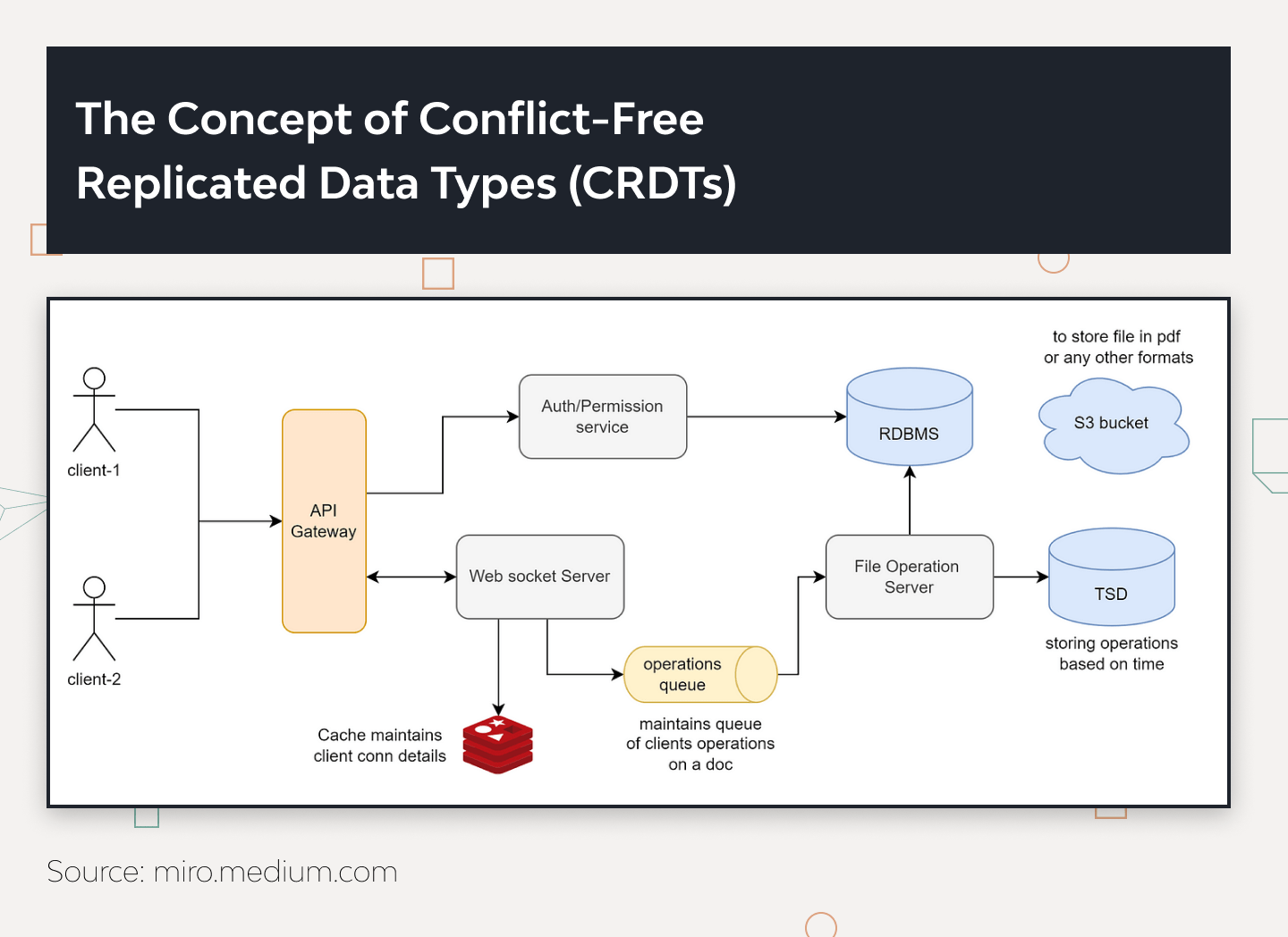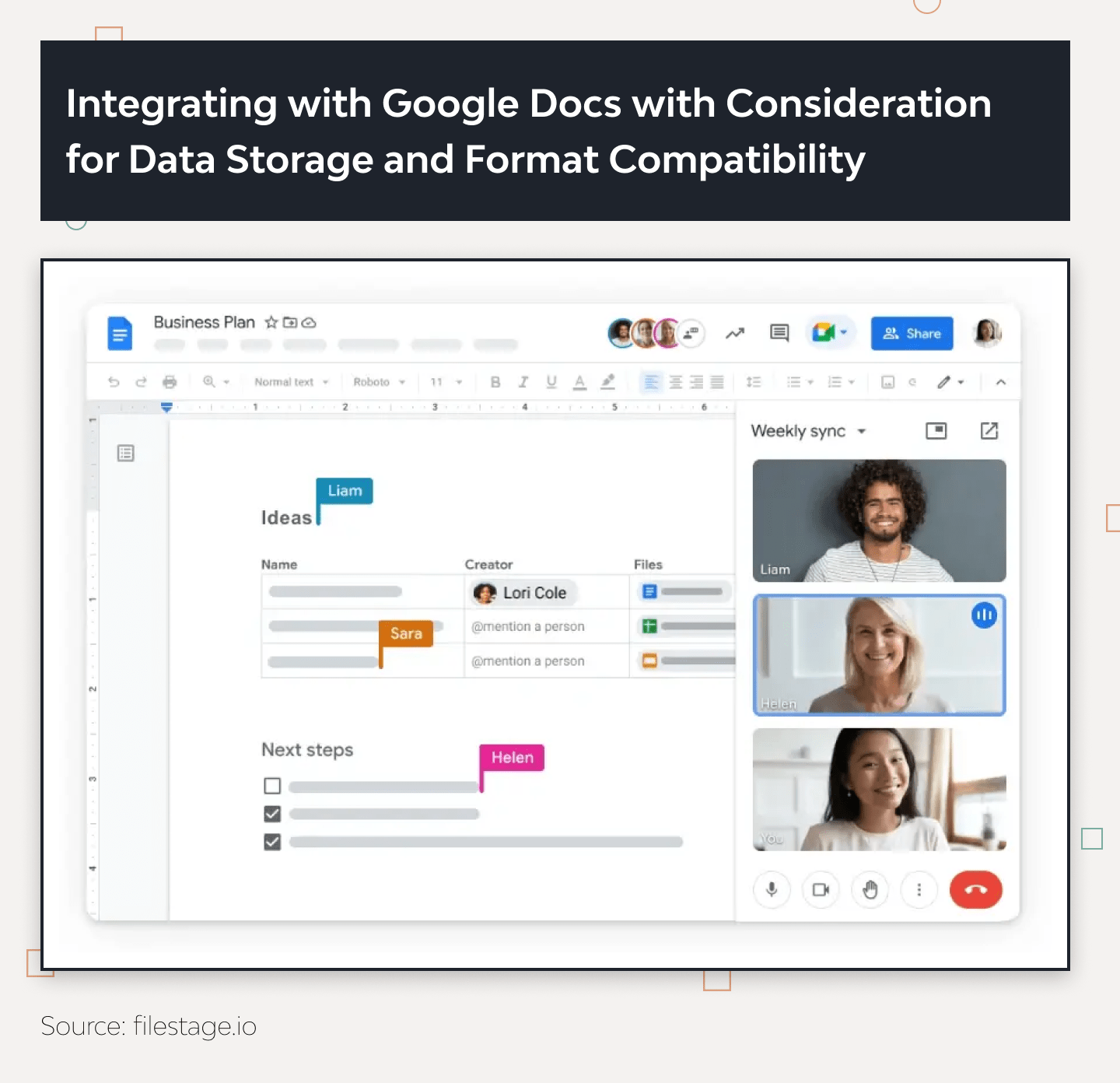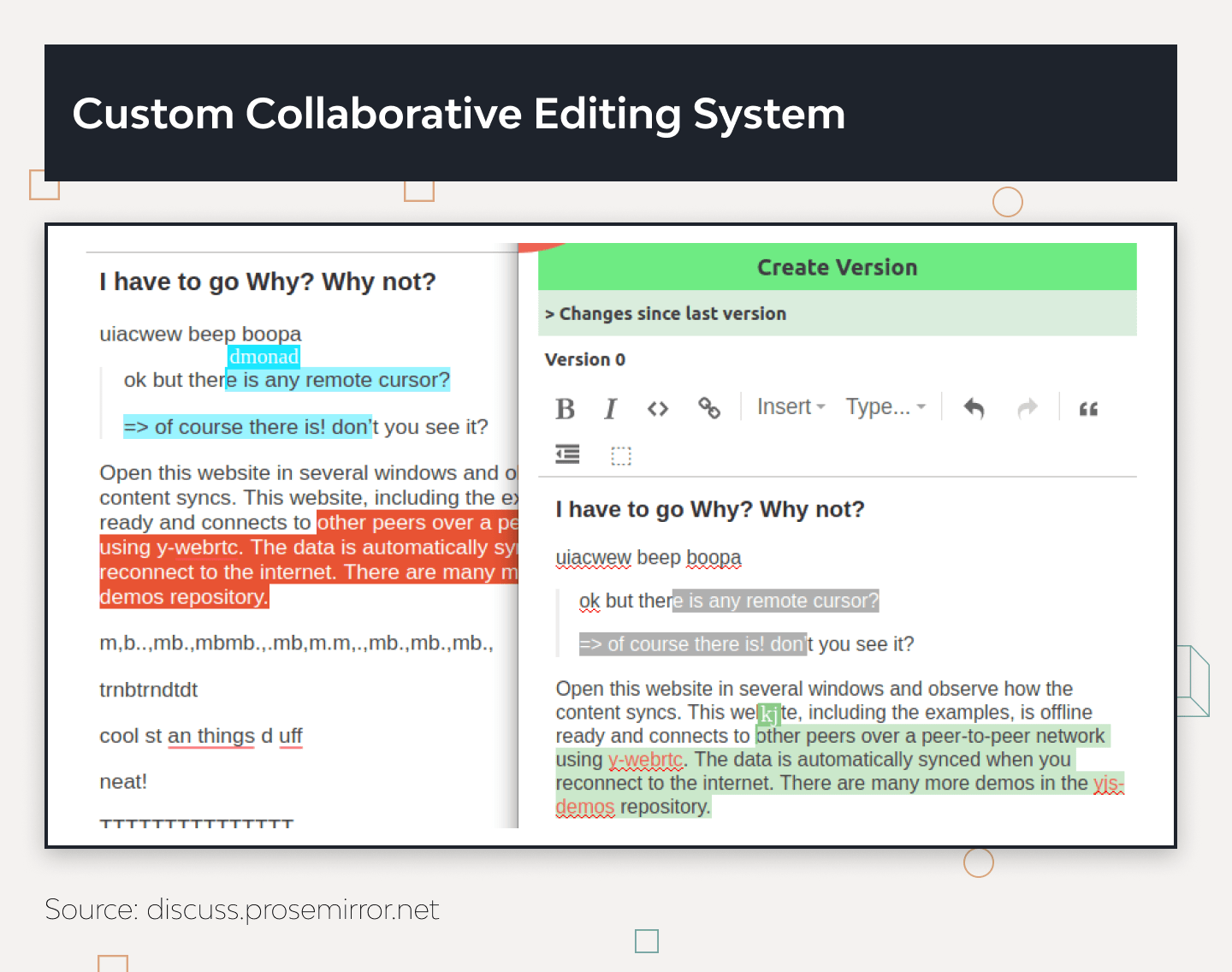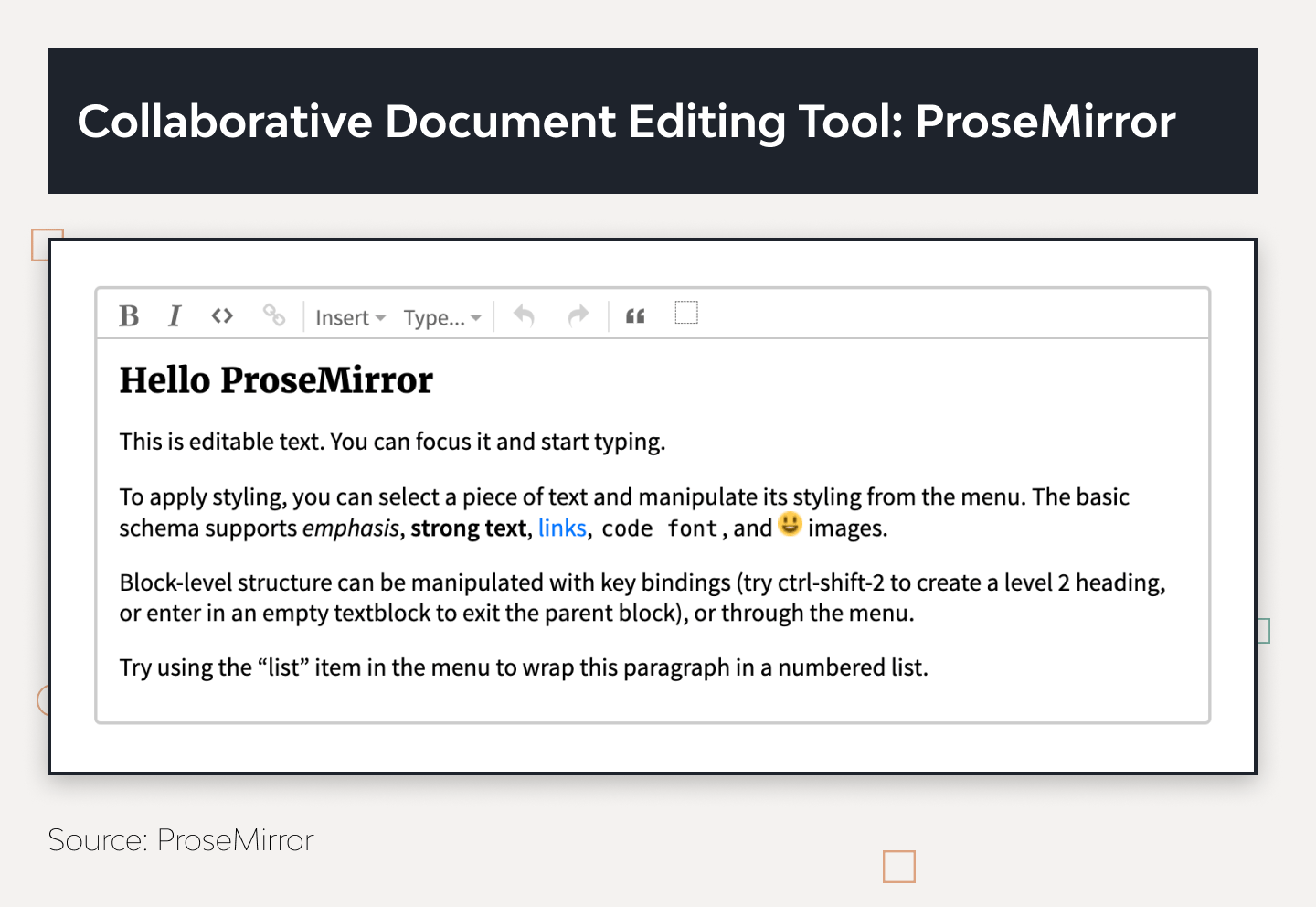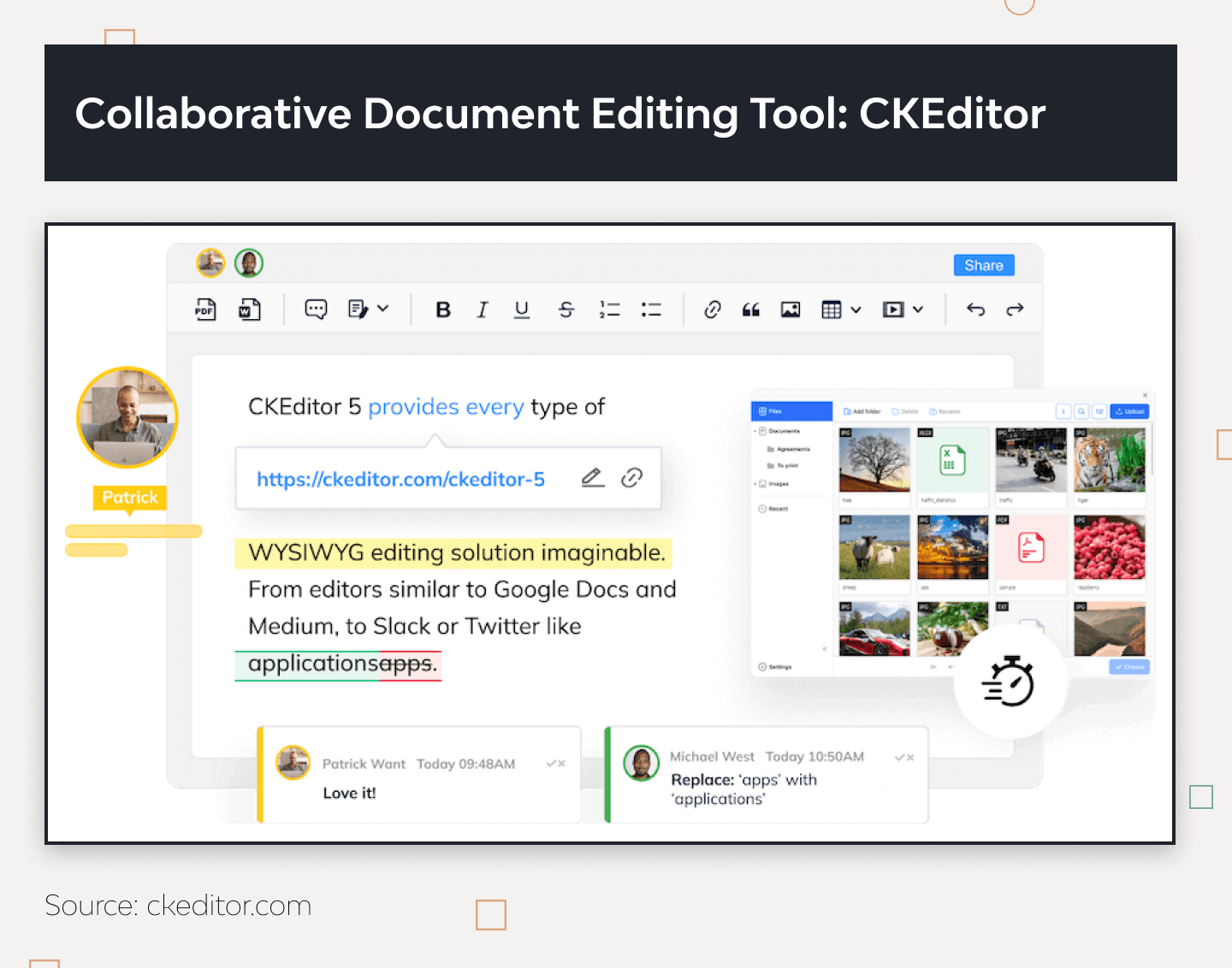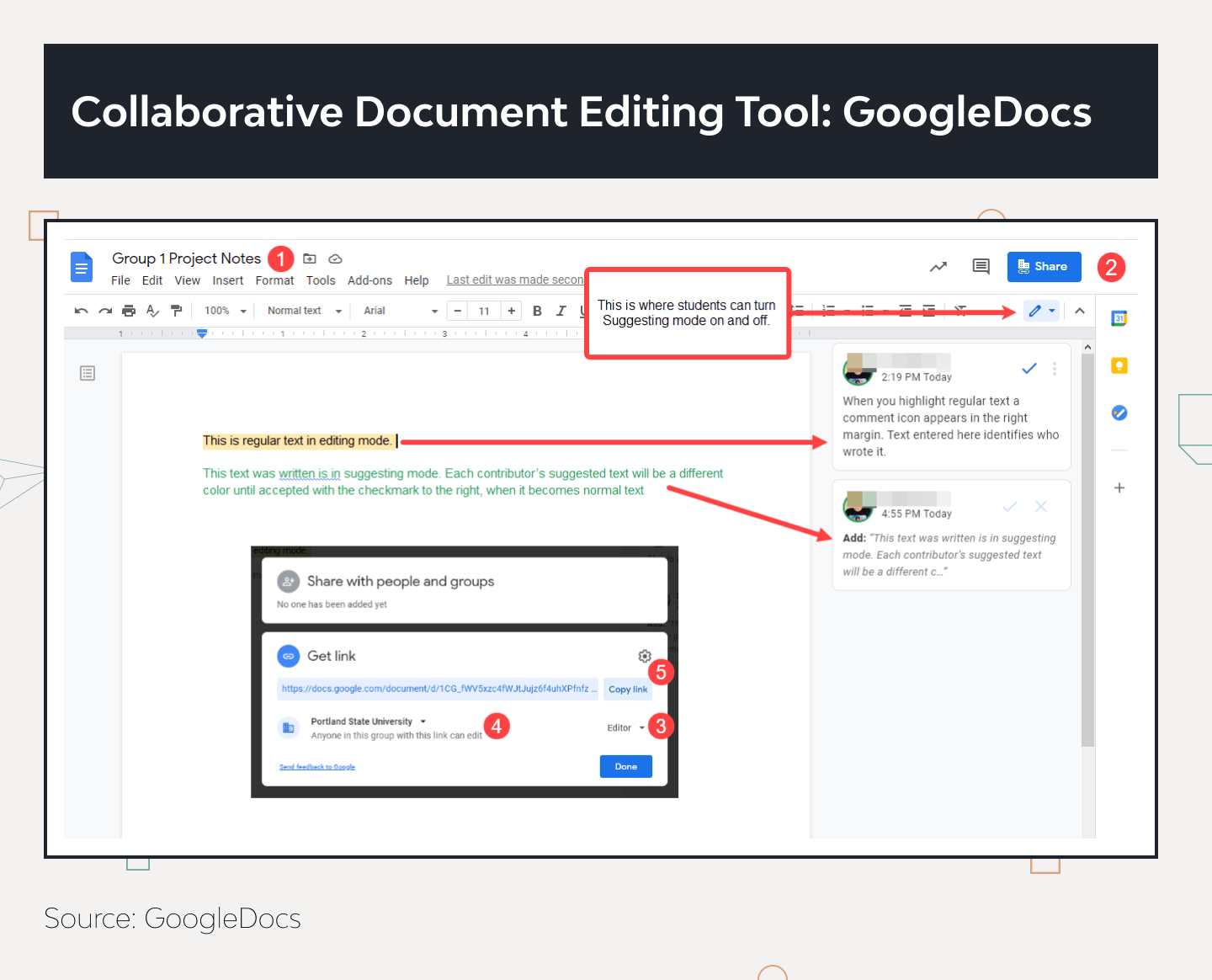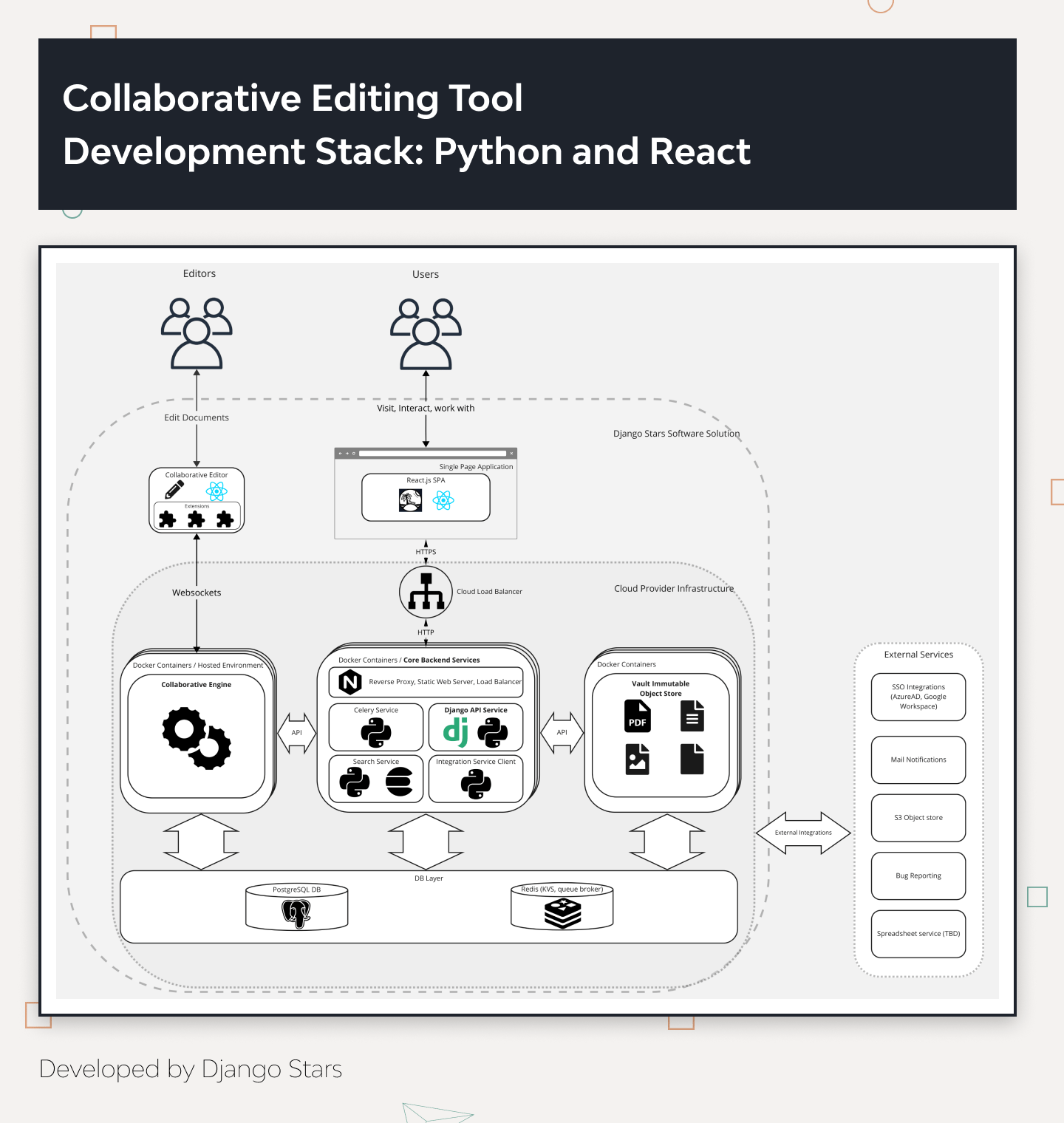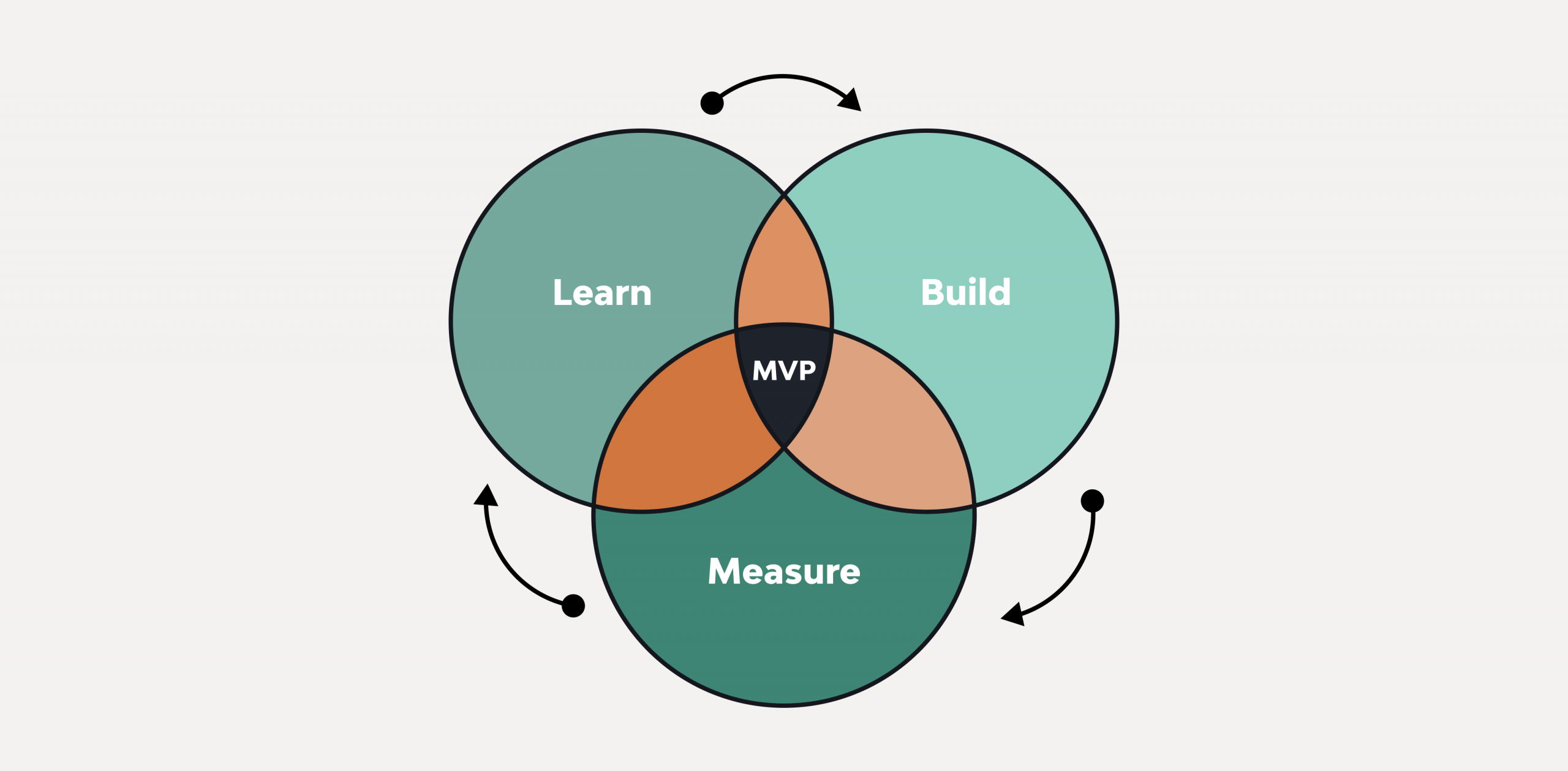System Design and Development of Collaborative Editing Tool

Managing complex engineering documentation, including technical drawings, variable data, and multiple simultaneous edits, is challenging without a robust collaborative editing system design. Version conflicts and data inconsistencies can disrupt workflows and delay projects.
Traditional methods of managing engineering documentation are inefficient and error-prone, leading to your current search for a more reliable tool.
In this article, we will:
- Explore the critical components needed for a successful collaborative editing tool
- Discuss our technical approach using Python and React
- Highlight our proven track record through detailed case studies and client testimonials
By the end, you will understand the key factors in choosing existing or collaborative editing tool development that fits your requirements.
Understanding the Technical Challenges
Consider the scenario where your engineering team is collaboratively editing a crucial document. As multiple team members make changes simultaneously, the risk of version conflicts increases. One user might delete a section while another is updating it, leading to inconsistencies and potential errors. This problem, known as version conflict, is a significant challenge in collaborative editing.
The concept of Conflict-free Replicated Data Types (CRDTs) has been developed to address this issue. CRDTs are sophisticated algorithms that ensure changes made by different users merge seamlessly without conflicts. They are helpful with designing a collaborative editing tool to synchronize all document versions, maintaining consistency and accuracy across all edits.
A notable solution leveraging CRDTs is CRDT.tech. This platform provides a robust framework for managing simultaneous changes and ensures all modifications are integrated smoothly for creating your own collaborative editing tool.
Approaches to Building Collaborative Editors
There are two main approaches to creating your own collaborative editing tool: using ready-made solutions or opting for custom development. Each approach has its own advantages and considerations.
Ready-Made Solutions
Utilizing ProseMirror Editor with Custom Enhancements
ProseMirror is a toolkit for building rich text editors. It is designed to be modular and customizable and provides real-time synchronization. You can add specific functionalities tailored to your business needs, such as incorporating technical drawings, variable data management, or other specialized content types.
Integrating with Google Docs with Consideration for Data Storage and Format Compatibility
Another approach is to integrate with an established platform like Google Docs. This option provides real-time editing and extensive format compatibility. However, it’s essential to consider the implications of data storage and security, as all data would reside on Google’s servers. Additionally, any specialized document formats or functionalities your business requires may require the development of custom add-ons or extensions.
Custom Collaborative Editing System Development
CRDT and Document Merging Logic with a Backend Library and a Basic Frontend Editor
A custom collaborative editing tool development approach involves implementing CRDTs to synchronize and merge document changes. By using a backend library that supports CRDTs, you can ensure that all edits are conflict-free and seamlessly integrated. Pairing this with a basic frontend editor provides a foundation upon which additional features can be built.
Yjs Editor and Its Extensibility for Customized Features and File Formats
Yjs is another excellent option for custom development. It is known for its CRDT implementation and support for real-time collaboration. You can integrate various file formats, implement custom features, and ensure real-time collaboration across your team.
Yjs’s modular architecture makes it adaptable to various use cases, from simple text editing to complex technical documentation involving diagrams and variables. We’ll describe how to build a collaborative editing tool in detail later in this blog post.
Components of a Collaborative Editing Tool
Developing a system design of collaborative editing tool involves integrating critical components to ensure a smooth user experience. Each element is vital in managing different aspects of the collaborative environment, from authentication to real-time synchronization.
API Gateway
An API Gateway is the entry point for all client requests for backend services. It handles routing, composition, and protocol translation, ensuring efficient and secure communication between the frontend and backend. The API Gateway can also manage authentication, rate limiting, and logging.
Authentication Service
The authentication service verifies users’ identities when accessing the collaborative editor. It ensures that only authorized personnel can access and edit documents. This service manages user sessions and permissions by integrating with systems like OAuth, LDAP, or custom authentication mechanisms.
Real-Time Synchronization Engine
A Real-Time Synchronization Engine ensures that all user changes are instantly reflected across all instances of the document. Utilizing technologies like WebSockets or server-sent events, this engine facilitates real-time collaboration, allowing multiple users to see and interact with each other’s changes in real-time.
Conflict Resolution Mechanism
Conflicts are inevitable when multiple users edit the same content simultaneously in a collaborative setting. A Conflict Resolution Mechanism automatically merges changes and resolves conflicts, often based on Conflict-free Replicated Data Types (CRDTs) or Operational Transformation (OT). This ensures that all contributions are integrated smoothly without losing any user edits.
Comment and Annotation Service
The Comment and Annotation Service allows users to leave comments, suggestions, and notes on specific document parts. This feature enables team members to discuss changes and provide feedback directly within the document. Integrating this service enhances the collaborative experience by allowing asynchronous interactions alongside real-time editing.
Document Management System
The Document Management System (DMS) handles document storage, retrieval, and versioning. It ensures that each version of a document is saved and can be accessed or restored as needed. The DMS maintains links to other documents. References remain consistent and unchanged even as the content evolves.
Variable Data Management
For scenarios where specific document attributes, such as aircraft load capacity, need to be configurable and consistent across multiple documents, a Variable Data Management component is one of the essential collaborative editing tool features. This allows users to define variables that can be reused and updated across different documents. Changes to these variables propagate automatically, ensuring that all references are updated accordingly, thereby maintaining data accuracy and consistency.
User Interface (UI) with Django and React
Combining Django for the backend and React for the frontend provides a robust and scalable solution for building the collaborative editor’s user interface. Django handles the business logic, data storage, and API endpoints, while React offers a dynamic and responsive user interface.
Notification and Alert System
A Notification and Alert System informs users about important events, such as comments, document updates, or conflict resolutions. This system can send real-time alerts through various channels, including in-app notifications, emails, or SMS.
Top Collaborative Document Editing Tools Overview
To create a successful collaborative document editing tool, it’s essential to understand the features, advantages, and limitations of existing best collaborative document editing tools in the market. Here’s an overview of some of the best collaborative document editing tools available.
ProseMirror
ProseMirror is a powerful toolkit for building a collaborative editing tool. It offers real-time collaborative editing, support for different content types, and plugin architecture for adding custom functionalities. ProseMirror is designed to be modular, allowing developers to integrate specific features.
Pros:
- Highly customizable and extensible
- Strong support for collaborative editing with real-time synchronization
- Modular design allows for targeted enhancements
- Extensive documentation and active community support
Cons:
- Requires significant development effort to set up and customize
- May have a steeper learning curve for new developers
- Out-of-the-box features are minimal, necessitating custom development
Use Cases: ProseMirror is good for businesses that need a customized editor with specific features for collaborative document editing, such as technical documentation, academic writing, or any application requiring rich text editing with real-time collaboration.
CKEditor and Suneditor
CKEditor is a versatile WYSIWYG editor that provides robust features for real-time collaboration, including multiple cursors and simultaneous editing. Suneditor is another WYSIWYG editor known for its simplicity and ease of integration, offering basic collaborative features.
CKEditor Pros:
- Rich set of features and plugins
- Real-time collaboration with visual indicators for multiple users
- Intuitive WYSIWYG interface
- Extensive support and regular updates
Suneditor Pros:
- Lightweight and easy to integrate
- Simple and user-friendly interface
- Good for basic editing needs
CKEditor Cons:
- Licensing costs for full features and commercial use
- Can be overkill for simple editing needs
Suneditor Cons:
- Limited collaborative features compared to CKEditor
- Less suitable for complex editing tasks
Use Cases: CKEditor is well-suited for applications requiring a robust and feature-rich editor with strong collaborative capabilities, such as enterprise document management systems or content management platforms. Suneditor is ideal for simpler applications with sufficient ease of use and basic collaborative editing.
Google Docs
Google Docs is a cloud-based word processing tool offering extensive collaborative features, including real-time editing, commenting, version history, and seamless integration with other Google Workspace tools. It supports many document formats and provides a familiar user interface.
Pros:
- Comprehensive set of collaborative features
- Real-time editing with multiple users
- Integrated commenting and suggestion tools
- Cloud-based with automatic saving and version history
- Seamless integration with Google Workspace
Cons:
- Data stored on Google’s servers raises privacy and security concerns for some users
- Limited customization options compared to self-hosted solutions
- Dependency on Internet connectivity
Use Cases: Google Docs is perfect for teams needing a reliable and familiar tool for collaborative editing, such as remote work environments, educational institutions, and any organization using Google Workspace for productivity. It’s good for general document creation, team projects, and real-time collaboration.
Addressing Specific Business Needs
When developing a collaborative editing tool for specific business requirements, such as those of an engineering company, it’s good to consider additional features beyond standard text editing. Custom collaborative editing system design can include diagram editing and real-time collaboration can significantly enhance the tool’s usability and effectiveness.
Integrating advanced features like simultaneous diagram editing into a collaborative editing tool poses several challenges. Collaborative editing tools should handle complex documents, much like Google Docs, but with added capabilities for technical drawings and images. This system should allow multiple users to edit documents simultaneously without any overlap or data conflicts.
The user interface must be straightforward, enabling users to easily make changes to documents that might include variables, which can automatically be adjusted and updated across all relevant documents. We must also ensure the system is secure, using proven methods to protect data and control who can see or alter documents.
Finally, once documents are finalized, the system should lock them to prevent further changes, ensuring all references and links remain intact and consistent. Such a platform can be user-friendly, robust, and secure, perfectly suited for dynamic business needs.
Dealing with Versioning and Conflict Resolution
Data consistency and resolving conflicts between multiple users’ edits can be challenging. Understanding the CAP theorem and implementing effective conflict management strategies are essential for creating a reliable and user-friendly system design of collaborative editing tool.
Exploring the Concept of CAP Theorem and Its Relevance
The CAP theorem, also known as Brewer’s theorem, states that in a distributed data store, only two out of the following three guarantees can be achieved simultaneously:
- Consistency. Every read receives the most recent write or an error
- Availability. Every request receives a response without guarantee that it contains the most recent write
- Partition Tolerance. The system continues to operate despite arbitrary partitioning due to network failures
In the context of collaborative editors, the CAP theorem is highly relevant because of:
- Consistency. Ensuring that all users see the same version of the document at any given time
- Availability. Providing real-time access and editing capabilities to all users, regardless of their geographical location
- Partition Tolerance. Maintaining functionality even when there are network disruptions or slow connections among users
For instance, prioritizing consistency and partition tolerance might reduce availability during network issues, while prioritizing availability and partition tolerance might lead to temporary inconsistencies.
Strategies for Managing Conflicts and Determining the Correct Version
Effective conflict resolution strategies are necessary to ensure that collaborative editing remains seamless and reliable. Here are some common strategies.
1. Operational Transformation (OT)
OT is a technique that allows multiple users to edit a document concurrently by transforming operations so that they can be applied in any order while maintaining consistency.
OT captures user operations (e.g., insert, delete) and transforms them based on the document’s current state before applying them. This ensures that all users see a consistent document state, regardless of the order in which operations are received.
2. Conflict-free Replicated Data Types (CRDTs)
CRDTs are data structures that allow multiple users to edit a document concurrently without requiring synchronization or locking mechanisms. CRDTs are designed to converge to the same state across all replicas, ensuring consistency.
CRDTs define operations that can be applied independently and still lead to a consistent state. For example, in a collaborative text editor, CRDTs might handle character insertions and deletions in a way that ensures all changes are merged correctly.
3. Version Vectors
Version vectors track the version history of each replica of the document, allowing the system to detect and resolve conflicts based on the versions of operations.
Each user’s changes are tagged with a version vector, which is updated with every operation. When changes are synchronized, the system uses these vectors to determine the correct order of operations and resolve conflicts.
4. Last Write Wins (LWW)
A simple strategy like Last Write Wins can be effective in scenarios where conflicts are rare or less critical. This approach resolves conflicts by accepting the latest change based on a timestamp.
Each operation is tagged with a timestamp. When a conflict is detected, the system compares the timestamps and applies the operation with the latest timestamp, ensuring that the most recent changes are preserved.
5. User Intervention
For complex conflicts that automated systems cannot resolve effectively, user intervention can be employed. This involves alerting users to conflicts and allowing them to manually merge changes.
The system detects conflicts and prompts users with a merge interface, where they can review and decide how to integrate conflicting changes. This approach is useful for maintaining control over critical document edits.
Collaborative Editing Tool Development Stack: Python and React
We can use Python for the backend and React for the frontend for developing a collaborative editing tool. This combination offers scalability, flexibility, and a seamless user experience.
Python Backend
Django is a high-level Python web framework encouraging rapid development and clean, pragmatic design. It’s known for its robustness and comprehensive features, making it ideal for building complex web applications.
For real-time collaboration, we integrate WebSockets to enable full-duplex communication channels over a single TCP connection in a custom collaborative editing tool development. This allows instant data transmission between the server and clients.
React Frontend
React is a JavaScript library for building user interfaces, particularly single-page applications where data can change dynamically without reloading the page. ProseMirror is integrated into the React application to provide a powerful and flexible rich-text editing experience.
React is used to build a responsive and intuitive user interface that enhances user experience. It communicates with the Django backend through RESTful APIs or GraphQL, enabling efficient data exchange and synchronization.
Django Stars Experience
At Django Stars, our approach combines deep technical expertise with a thorough understanding of our clients’ business requirements, enabling us to deliver robust and scalable solutions.
Collaborative Technical Document Editor for an Aviation Company
An aviation engineering company needs a collaborative editor to manage its engineering documentation. The editor needed to support real-time collaboration, incorporate technical drawings, and handle variable data management for specifications like aircraft load capacity.
We’d like to describe how we would develop a collaborative editing tool using Django and React. The backend, powered by Django, handles user authentication, real-time synchronization using WebSockets, and complex data management with PostgreSQL.
The frontend is built with React It provides an intuitive and responsive user interface, integrating ProseMirror for text editing and Draw.io for diagram management. Or we can take the Yjs editor, which uses the CRDT abstraction for further customization and expansion with the file formats we need.
This is what we’d add to the collaborative editing system design core features:
- Real-Time Collaboration. Using WebSockets and CRDTs, we ensure that multiple users can edit documents simultaneously without conflicts
- Variable Data Management. Implemented features allow variables such as aircraft load capacity to be defined and reused across different documents. Changes to these variables propagate automatically, ensuring consistency
- Version Control and History. It allows users to track changes, revert to previous versions, and maintain a complete history of document edits
- User Authentication and Authorization. Secure authentication and role-based access control ensures only authorized users could access and edit documents
- Diagram Editing. Creating and editing technical diagrams are integrated directly within the editor
Conclusion
In designing and developing a collaborative editing tool for engineering documentation, addressing version conflicts and data inconsistencies is a good practice. Solutions like CRDTs can help manage simultaneous edits without issues. Both ready-made solutions (e.g., ProseMirror, Google Docs) and custom development approaches are viable, each with specific benefits.
Essential components for a robust tool include an API Gateway, Authentication Service, Real-Time Synchronization Engine, and Document Management System. Utilizing Django and React can ensure a scalable and user-friendly interface. Diagram editing and variable data management are additional featues for enhancing usability and functionality.
At Django Stars, our extensive experience in developing web tools is backed by successful case studies and positive client testimonials. Our proven track record demonstrates our ability to deliver high-quality, customized solutions that enhance productivity and streamline workflows. Let’s discuss how we can help you develop a powerful collaborative editing tool tailored to your unique requirements.
- How Does Real-Time Collaborative Editing Work?
- Real-time collaborative editing tools synchronize changes made by multiple users simultaneously. All edits are reflected instantly across all document instances. This is achieved through technologies like Conflict-free Replicated Data Types (CRDTs) or Operational Transformation (OT), which manage and merge changes without conflicts.
- How Long Does It Take to Build a Collaborative Editing Tool?
- A basic tool with core functionalities might take a few months. In contrast, a more sophisticated system with advanced features like variable data management, diagram editing, and extensive real-time synchronization could take longer, potentially up to a year or more.
- Why Should I Use a Collaborative Editing Tool in Project Management?
- A collaborative editing tool enhances project management by allowing multiple team members to work on documents simultaneously, reducing the risk of version conflicts and data inconsistencies. It improves efficiency, ensures real-time updates, and facilitates better communication and collaboration among team members.
- What are the Essential Components of a Collaborative Editing Tool?
- Key components of a collaborative editing tool include an API Gateway for efficient communication, an authentication service for secure user access, a real-time synchronization engine for immediate update reflection, and a document management system for storage and version control.
- Can I Customize a Collaborative Editing Tool to Fit My Business Needs?
- Yes, collaborative editing tools can be customized to fit specific business requirements. Whether you need specialized features like technical drawing integration, variable data management, or custom user interfaces, both ready-made solutions and custom development approaches can be updated to meet your unique needs.

